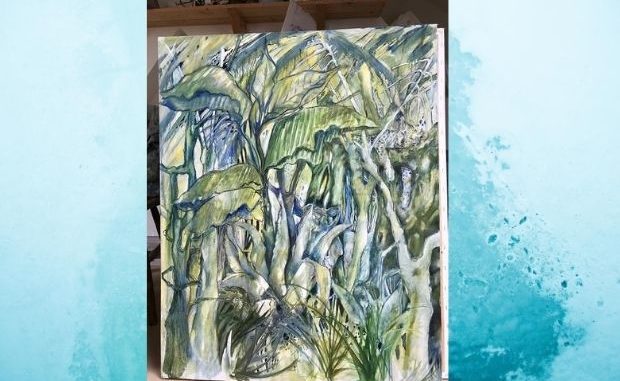
Two Kent artists who have previously staged successful environmentally-themed exhibitions are planning another, this time with the emphasis on the devastating impact the world’s population explosion has on our planet.
Thelma Findlay, from Broadstairs, and Marilyn Orpin, from Minster on the Isle of Sheppey, have been friends since they studied for fine art degrees at Canterbury’s University for the Creative Arts.
Conservation and the pollution of our planet has been a recurring theme of their work.
Last year, Ramsgate’s York Street Gallery was the venue for “U-Turn Now,” the pair’s exhibition of paintings, prints, collages and examples of objects found on Kent’s beaches.
Their exhibition the previous year, 2018, ”SOS – Save Our Seas,” had a similar theme. Thelma and Marilyn’s aim was to increase awareness of the devastating and often deadly impact plastic pollution can have on our seas and marine life.
This time, Marilyn and Thelma are turning their attention to another key environmental issue- how the doubling of the world’s population in just 50 years from 1970 to the present is having a massive effect on the planet and its wildlife.
“Wild About Life,” is their latest artistic effort to highlight some of the threats. The works can be seen at The Margate School (formerly Woolworths) at 31-33 High Street Margate from August 13-19, from 10am to 4pm each day.
Marilyn said: “The impact on the planet of the human population explosion has become so great that we have forgotten that we are animals, too. We are now discovering that we are as vulnerable as all the other species. Trade in live wild animals increases the chances that a virus can jump from one species to another. The imbalance has slipped too far.”
Thelma added: “Since 1980 more than half the increase in food production has been at the expense of intact forests. We are producing a mountain of waste and plastic pollution that has increased 10-fold.
“We are swamping our wonderful Earth and ruining it with our own need and greed. Since the Covid-19 outbreak and self- isolation I have realised the urgent need to protect the world and its treasure trove- our opportunity is now.”
The pair say around one million animal species are at risk of extinction. Forests are being cleared at an alarming rate to produce food crops, or animal feed. For example, the number of tigers has decreased by 96 % in the last century, either by hunting, de-forestation or more recently the demand from some Far East countries for so-called aphrodisiac properties of tiger body parts.
The same fate has befallen the African rhino and the Pangolin, which have been slaughtered in their thousands over the last decade for the alleged medicinal properties of their horns and scales.
Marilyn added: “Deforestation to clear space for palm oil in Indonesia and Borneo has led to the Orangutan being critically endangered as its habitat disappears. To make matters worse, up to 3,000 of these beautiful, gentle animals are killed for food each year.”
Giant factory fishing vessels are also plundering the seas. Last month, a fleet of more than 200 Chinese trawlers arrived off the Galapagos Islands. They stayed just outside Ecuador’s 200-mile territorial limit, but a fishing fleet of this size is, as the Ecuadorian government pointed out, enough to totally destroy the Galapagos Islands’ fragile eco-system.
“Even the animals in our back gardens are under threat,” says Thelma. “According to a new UN-approved list issued by the Mammal Society, one in four UK mammal species faces the threat of extinction. These include the hedgehog, the hazel dormouse and the water vole.”
“We feel that there is never a more appropriate moment to have an exhibition such as “Wild About Life” to get the message across, even in a small way, ” said Marilyn. “The future depends on what we do now, we must leave a better tomorrow. How ironic if we were, eventually, to become the architects of our own mass extinction event and disappear from the planet, just as the dinosaurs did.”

